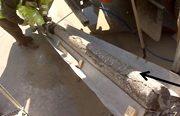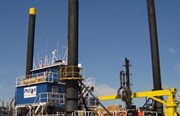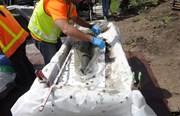Sonic For Science Part 2: Geochemical Analysis of Rare Earth Elements In Florida's Bone Valley
By: CascadeIn our Sonic for Science Part 1, we talked about the beginnings of a project on geochemical analysis of rare earth elements (REEs) taking place at Florida State University. Masters student Kyle Turner is investigating phosphate deposits of West Central Florida in order to better understand their depositional environments as well as answering the question if they offer a solution to global REE demand. Phase 1 of the project started with field sampling, wherein Mr. Turner partnered with Cascade to obtain core samples via sonic drilling technology. Using sonic allowed the Cascade team to deliver core samples that were the best quality the Florida State Team had ever seen. The samples were then brought back to the National High Magnetic Field Laboratory for in depth analysis.
Now, let’s take a look at phase 2 - the results and conclusion Mr. Turner has put together thus far. Some of these details were provided in Part 1 but only in basic context. With more lab time and a wider range of results, more information is now available.
Phase 2: Geochemical Analysis
Post site investigation, Core samples were brought back to Florida State University in custom made aluminum core boxes, where they could be stored throughout the duration of the project. Mr. Turner and his research team cut each core open, pulling samples approximately 1-3 grams in size from locations covering the entire span of the core. By just taking a quick look at each sample, it was evident that sands and silts in the chosen sampling area contained extremely high amounts of pebble sized phosphate, as well as fragments of fossilized bones and teeth. Once samples were pulled from each core, they were taken to a lab on campus where they were dried down, removing any remaining water, necessary because the phosphate rich unit existed within the surficial aquifer system.
Once dry, samples were examined using a microscope, where individual phosphate grains, teeth, bones, and fossils were separated from the sand/silt/clay matrix. Phosphate grains were placed in 5mL plastic containers and taken to the lab where they were weighed and powdered for geochemical analysis. Phosphatic samples (10-20mg) were placed in clean Savilex vials and taken to the National High Magnetic Field Laboratory for the next steps of the analysis process.
Francolite, a carbonate rich Flourapatite, is the dominate phosphate mineral of the Bone Valley Member. In addition to phosphate itself, the crystal lattice structure of the mineral contains Ca, Mg, Sr, Na, F, and REEs, which is the targeted element(s). Powered Flourapatite was taken into the trace metal clean lab were multiple ratios of acids were used in order to digest the sample completely for analysis using Inductively Coupled Plasma Mass Spectrometry (ICP-MS). Upon digestion, samples were brought up to a known volume in dilute nitric acid, while the same procedure was completed for standards.
Digested samples are being analyzed using ICP-MS. The Agilent 7500cs q1 ICP-MS takes liquid samples mixed with gas (typically Argon) and heats the sample upwards of a couple thousand degrees centigrade, causing the atoms in the sample to form ions. The ICP-MS then separated ions in the plasma based on their charge and passes them through a series of cones, before producing a value of counts per second, which can then be converted to a concentration using mathematics. Advantages to using the Agilent 7500cs q1 ICP-MS include the time required per sample in that 15 samples can be run in about one hour, and the numerical output is typically already in concentration form, typically parts per billion (ppb). Elemental analysis using ICP-MS allows for a breakdown of each elemental component of the sample, clearly showing what elements are making up each mineral in a sample.
Results
Upon analysis of nearly 100 samples from across the southern portion of the Central-Florida Phosphate District, interesting trends began appearing. As a whole, phosphatic samples yielded REE concentrations reaching values as high as 300 parts per million (ppm), with a mean of around 75 ppm for light REE and 25 for heavy REE. Biogenic phosphate samples do not contain near the amount of REE as non-biogenic, however are still enriched when compared to Post Archean Australian Shale (PAAS). Uranium concentrations appear to be extremely enriched with values reaching greater than 1,000ppm. Strontium (Sr) isotope ratios obtained for the top and bottom of each core correlate nicely with previous biostratigraphic ages. It has been determined from Sr isotope ratios that Peace River Formation phosphates were deposited as early as the lower Miocene (~20 million years), and continued to do so through the Pleistocene (~11,700 years ago). The wide age range coming from samples only 87 feet apart suggest low sedimentation rates throughout the Neogene and Quaternary, meaning sediments off the coast of Florida experienced long episodic events of coastal winnowing, being tossed back and forth in the surf due to wave action.
Conclusions
The vast amounts of phosphate present in west central Florida may offer a solution to the global demand for REEs. Considering Florida mines 80% of the nearly 30 million metric tons of phosphate produced annually in the United States, medium to low concentrations of REEs could yield great reward. For example, average values for the REE Neodymium (Nd) in this study would yield nearly 1.1 million kg of ore annually if concentrations were consist across the district, while Holmium (Ho) could yield 163,000 kg.
Though the ease of recovery from phosphatic materials has yet to be studied in detail, as demand continues to rise, Florida phosphorites should be considered as a possible source for REEs.
For more info on REE’s in Florida’s Bone Valley, read part 1 of this blog, and make sure to check out our blog for all sorts of updates from Cascade.
If you have questions related to this specific project, feel free to reach out Kyle Turner.













